Purple-flowered trees are a stunning addition to any garden or landscape. Not only do they add a pop of color, but they also provide shade and beauty throughout the year. There are many different types of trees that produce purple flowers, each with unique characteristics and growing requirements. In this article, I will share with you 10 varieties of trees with purple flowers that you can consider for your garden.
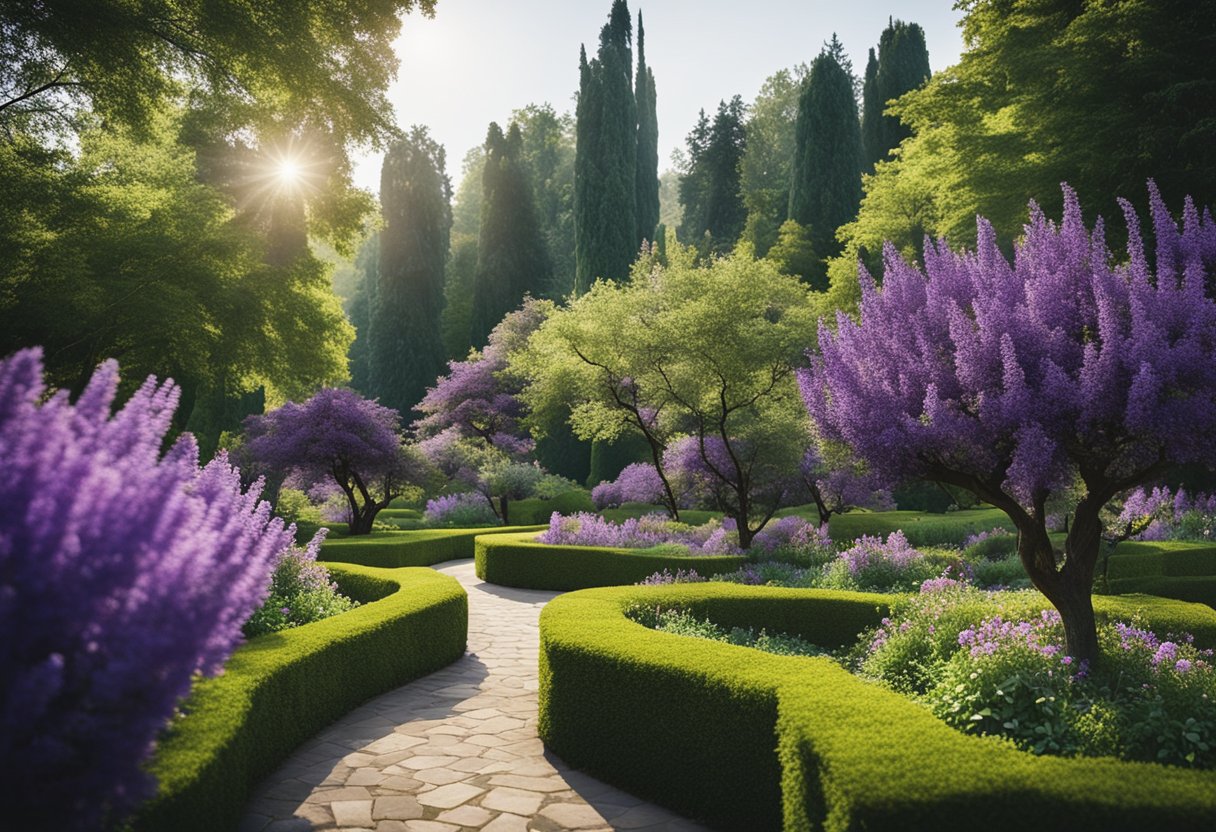
When choosing a purple-flowered tree, it is important to consider factors such as size, shape, and bloom time. Some trees may grow tall and wide, while others may have a more compact habit. Some trees may bloom in the spring, while others may bloom in the summer or fall. By understanding the characteristics of different types of purple-flowered trees, you can choose the perfect one for your garden.
Key Takeaways
- There are many different types of trees that produce purple flowers, each with unique characteristics and growing requirements.
- When choosing a purple-flowered tree, it is important to consider factors such as size, shape, and bloom time.
- By understanding the characteristics of different types of purple-flowered trees, you can choose the perfect one for your garden.
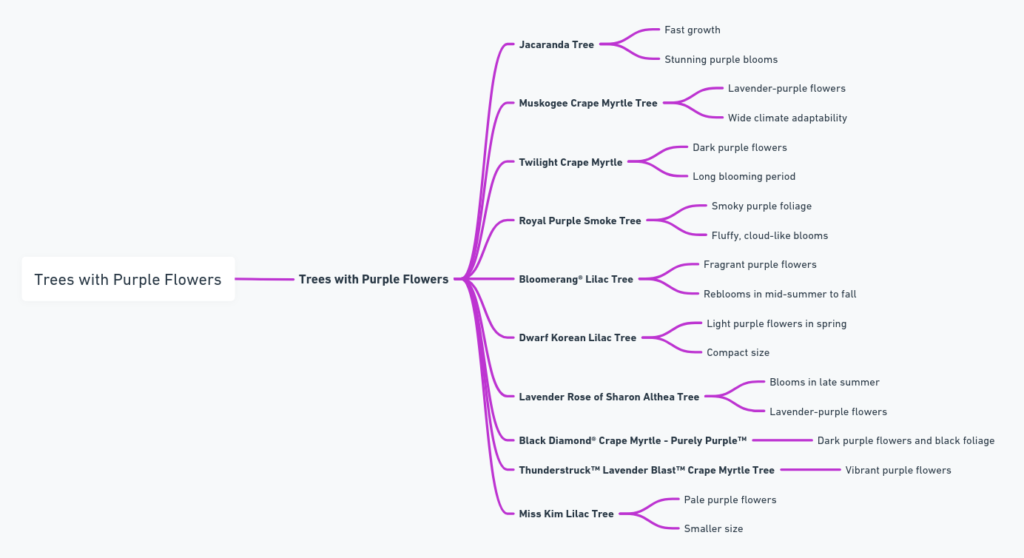
Characteristics of Purple-Flowered Trees
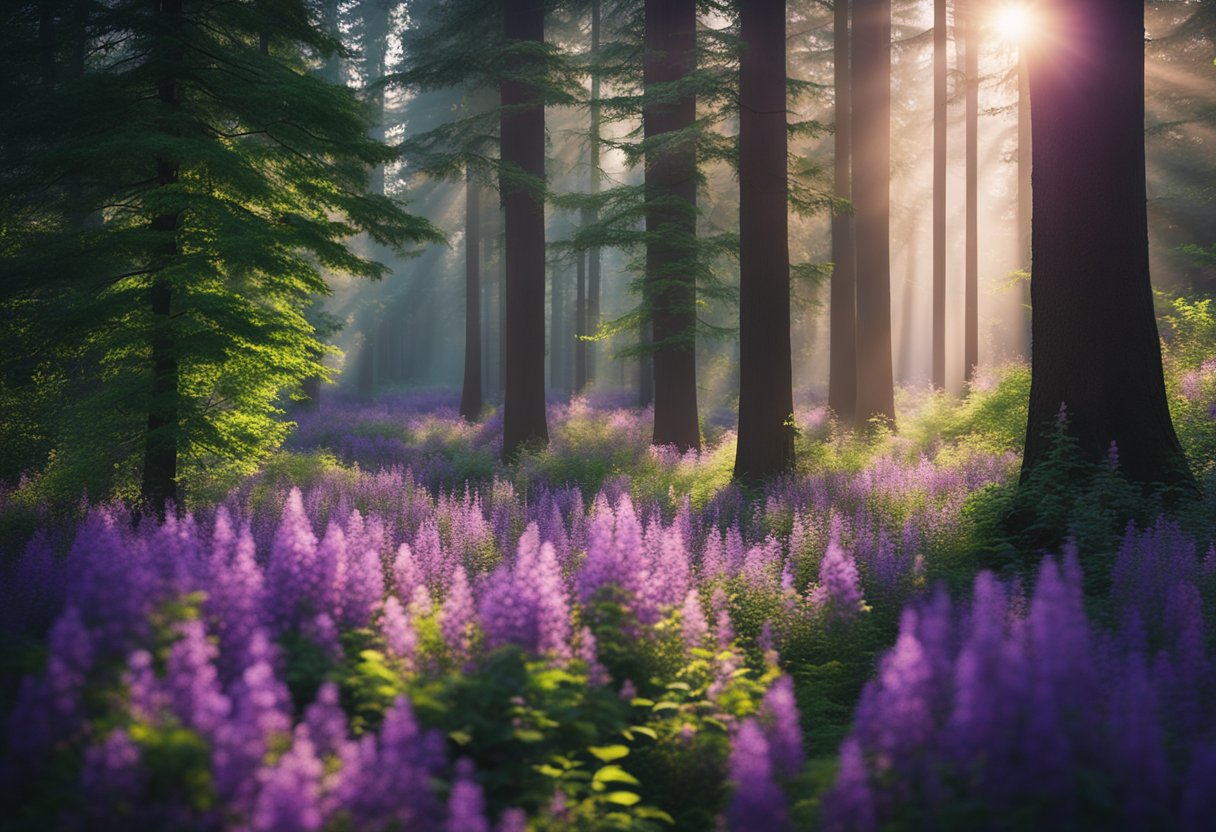
As a horticulturist, I have come across several trees with purple flowers. These trees are a great addition to any garden due to their vibrant color and unique appearance. Here are some characteristics of purple-flowered trees that you should know:
Flower Color
Purple-flowered trees have flowers that range in color from light lavender to deep purple. Some trees may have flowers that are mixed with other colors such as pink, white, or red. The color of the flowers can vary depending on the species, the soil pH, and the amount of sunlight and water the tree receives.
Flower Shape
The shape of the flowers can also vary depending on the species of tree. Some trees have small, delicate flowers that grow in clusters, while others have large, showy flowers that bloom individually. The shape of the flowers can have a significant impact on the overall appearance of the tree.
Tree Height
Purple-flowered trees can vary in height from small shrubs to towering giants. Some trees, such as the Jacaranda tree, can grow up to 50 feet tall, while others, such as the Crape Myrtle, only reach a height of 10-15 feet.
Leaf Shape and Color
The leaves of purple-flowered trees can also vary in shape and color. Some trees have small, delicate leaves that are a light green color, while others have large, bold leaves that are a dark purple color. The shape and color of the leaves can add to the overall appearance of the tree.
Purple-flowered trees are a beautiful addition to any garden or landscape. Their unique appearance and vibrant color make them stand out from other trees. When selecting a purple-flowered tree, consider the flower color, shape, tree height, leaf shape, and color to ensure that you choose the right tree for your space.
Royal Empress Tree
The Royal Empress Tree (Paulownia tomentosa) is a fast-growing deciduous tree that is known for its beautiful purple flowers. It is also commonly known as the Princess Tree or the Foxglove Tree. The tree is native to China, but it has been introduced to many other parts of the world, including the United States.
Growth Habit
The Royal Empress Tree is a large tree that can grow up to 60 feet tall and 40 feet wide. It has a straight trunk and a broad, rounded crown. The leaves of the tree are large and heart-shaped, and they can grow up to 12 inches long. The tree is a fast grower, and it can grow up to 15 feet per year in ideal conditions.
Flowering Season
The Royal Empress Tree blooms in the spring, usually in April or May. The tree produces large clusters of fragrant, trumpet-shaped flowers that are a beautiful shade of purple. The flowers can grow up to 14 inches long and 8 inches wide. They are followed by large, brown seed pods that can grow up to 18 inches long.
The Royal Empress Tree is a beautiful and fast-growing tree that is a great addition to any landscape. Its large size and fast growth make it ideal for use as a shade tree, and its beautiful purple flowers make it a standout in any garden.
Jacaranda Tree
The Jacaranda Tree is one of the most beautiful trees that produce purple flowers. It is native to South America but is now commonly found in many parts of the world, including Florida, Jamaica, and Japan. This tree is known for its stunning display of purple flowers, which bloom in the spring and early summer.
Cultural Significance
The Jacaranda Tree has significant cultural importance in many countries. In South Africa, the Jacaranda Tree is known as the “City of Johannesburg’s Tree” because of its abundance in the city. The tree is also a symbol of Pretoria, the capital city of South Africa. In Brazil, the Jacaranda Tree is a national symbol and is protected by law.
Landscape Uses
The Jacaranda Tree is a popular choice for landscaping because of its beautiful purple flowers and its ability to provide shade. It is often used as a street tree or as a specimen tree in gardens and parks. The tree can grow up to 50 feet tall and has a spread of up to 30 feet. It prefers well-drained soil and full sun but can tolerate some shade.
Here are some additional facts about the Jacaranda Tree:
- The tree is deciduous, which means it loses its leaves in the winter.
- The flowers of the Jacaranda Tree are trumpet-shaped and can range in color from light purple to deep violet.
- The wood of the Jacaranda Tree is used to make furniture, musical instruments, and decorative items.
- The tree is also known for its medicinal properties. The bark and leaves of the tree have been used to treat a variety of ailments, including fever, coughs, and rheumatism.
The Jacaranda Tree is a beautiful and culturally significant tree that is popular for landscaping. Its stunning display of purple flowers and its ability to provide shade make it a popular choice for many homeowners and landscapers.
Eastern Redbud
Eastern Redbud (Cercis canadensis) is a small deciduous tree that is native to eastern North America. It is known for its beautiful pink to purple flowers that bloom in early spring before the leaves emerge. Eastern Redbud is a popular ornamental tree that is widely planted in gardens and parks.
Foliage Description
Eastern Redbud has heart-shaped leaves that are 3-5 inches long and wide. The leaves are green in the summer and turn yellow in the fall. Some cultivars have purple or burgundy-colored leaves that add interest to the landscape. Eastern Redbud is a relatively small tree that typically grows 20-30 feet tall and wide.
Care and Maintenance
Eastern Redbud is a relatively easy tree to grow and maintain. It prefers well-drained soil and full sun to partial shade. Eastern Redbud is tolerant of a wide range of soil types and pH levels. It is also resistant to pests and diseases. Eastern Redbud does not require pruning, but it can be shaped or trained to a single stem if desired.
Here are a few tips for caring for Eastern Redbud:
- Water regularly during the first few years after planting to help the tree establish its roots.
- Mulch around the base of the tree to help retain moisture and suppress weeds.
- Fertilize in early spring with a balanced fertilizer to promote healthy growth and flowering.
- Watch for signs of stress, such as wilted leaves or yellowing foliage, and address any problems promptly.
Eastern Redbud is a beautiful and low-maintenance tree that is well-suited for gardens and landscapes.
Texas Mountain Laurel
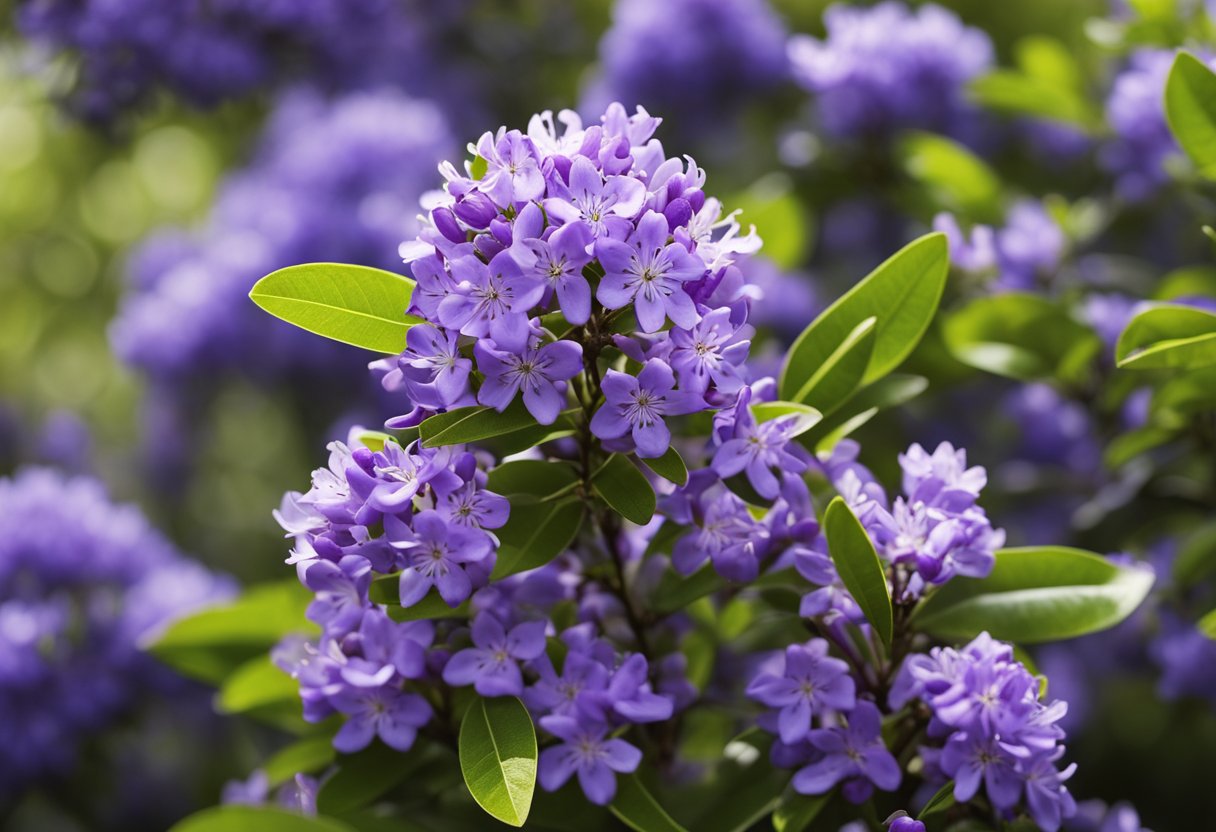
As a lover of purple flowers, I cannot help but mention the Texas Mountain Laurel tree. This evergreen tree is native to Texas and New Mexico and is known for its beautiful and fragrant purple flowers that bloom in the spring.
Toxicity and Safety
One thing to keep in mind when considering planting a Texas Mountain Laurel tree is its toxicity. The seeds, leaves, and bark of this tree contain a toxic compound called cytisine, which can cause severe gastrointestinal distress if ingested. Therefore, it is essential to keep this tree away from children and pets who may be tempted to eat the attractive seeds.
Soil Preferences
Texas Mountain Laurel trees prefer well-drained soils and can tolerate a wide range of soil types. However, they do best in soils that are slightly acidic and have good drainage. If the soil is too alkaline, the tree may develop yellow leaves due to iron chlorosis.
The Texas Mountain Laurel is a stunning tree that can add a pop of purple to any landscape. However, it is essential to be aware of its toxicity and ensure that it is planted in a safe location away from children and pets. Additionally, planting it in well-drained, slightly acidic soil will help it thrive.
Chaste Tree
The Chaste Tree (Vitex agnus-castus) is a deciduous shrub or small tree that produces spikes of fragrant, lilac-colored flowers in late summer. It is a popular choice for gardeners due to its attractive foliage and showy blooms.
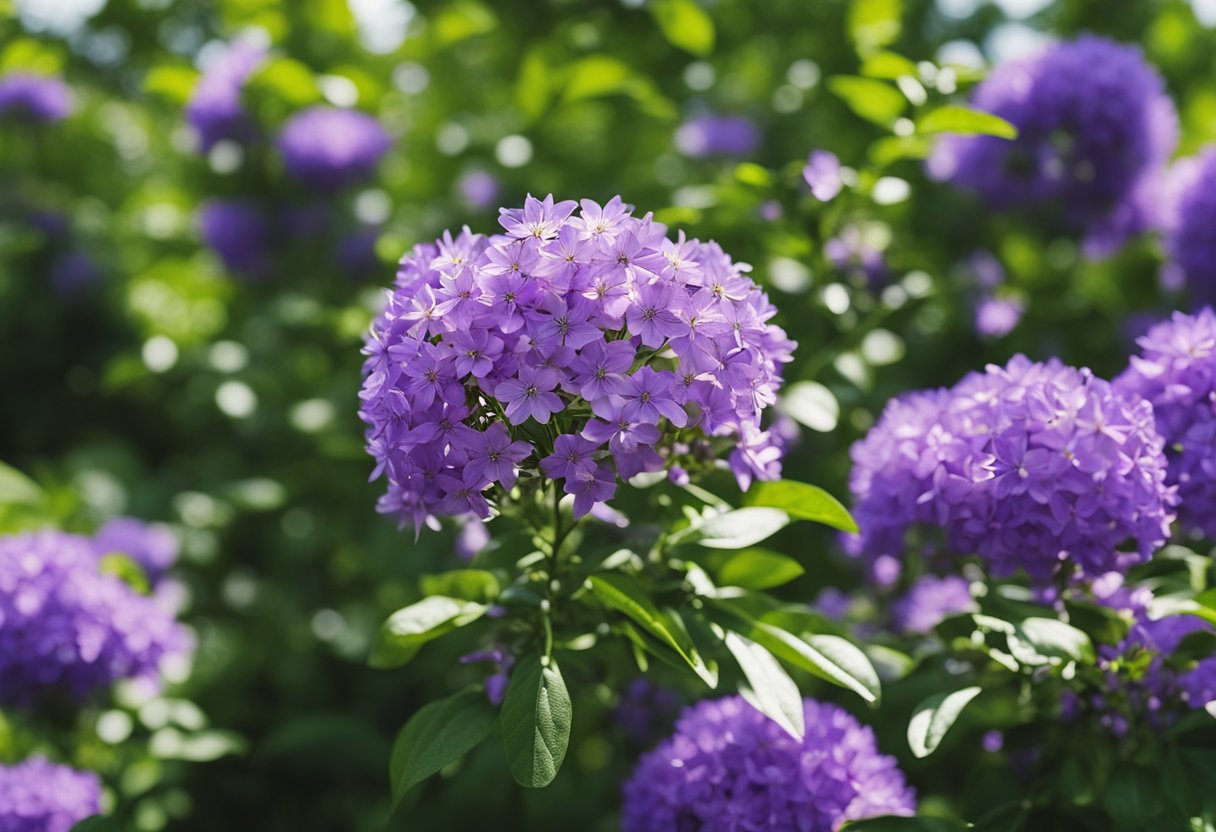
Attracting Wildlife
The Chaste Tree is a great choice for gardeners looking to attract wildlife to their yard. Its flowers are known to attract bees, butterflies, and hummingbirds, making it a great addition to any pollinator garden. Additionally, the Chaste Tree’s berries are a favorite food source for birds, particularly finches and sparrows.
Drought Resistance
The Chaste Tree is known for its drought tolerance, making it a great choice for gardeners in hot, arid climates. It can withstand long periods of drought once established, and requires little to no supplemental watering. However, it is important to note that the Chaste Tree prefers well-draining soil and may suffer from root rot if planted in overly wet conditions.
The Chaste Tree is a great choice for gardeners looking for a low-maintenance, drought-tolerant plant that attracts wildlife to their yard. Its attractive foliage and showy blooms make it a popular choice for gardens of all sizes.
Purple Leaf Plum Tree
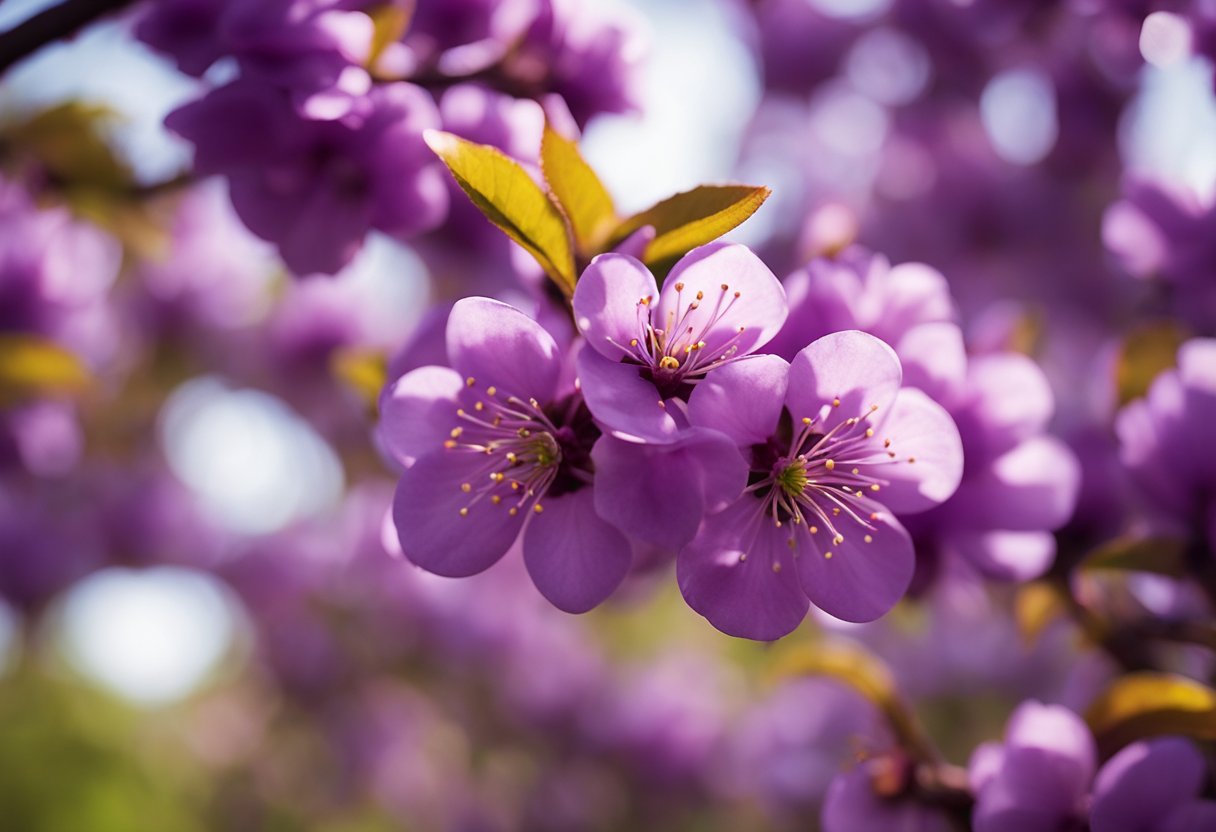
The Purple Leaf Plum Tree, also known as Prunus cerasifera, is a deciduous tree that is native to Asia. This tree is known for its stunning, deep purple foliage that adds a pop of color to any landscape. In addition to its attractive leaves, the Purple Leaf Plum Tree also produces beautiful pink flowers in early spring before the leaves emerge.
Fruit Production
While the Purple Leaf Plum Tree is primarily grown for its ornamental value, it does produce edible fruit. The fruit is small and round, similar in size to a cherry. It is usually yellow or red in color and has a sweet, juicy flavor. However, the fruit is not commonly harvested for consumption as it is not as flavorful as other fruit-bearing trees.
Pruning Requirements
The Purple Leaf Plum Tree requires minimal pruning to maintain its shape and size. It is recommended to prune the tree in late winter or early spring before new growth emerges. This will help to promote healthy growth and maintain the tree’s overall shape. It is important to avoid heavy pruning as this can damage the tree and reduce its overall health.
The Purple Leaf Plum Tree is a beautiful addition to any landscape. Its stunning purple foliage and delicate pink flowers make it a popular choice among homeowners and landscapers alike. While it does produce edible fruit, it is primarily grown for its ornamental value. With minimal pruning requirements, this tree is easy to maintain and will provide years of beauty to any outdoor space.
Purple Orchid Tree
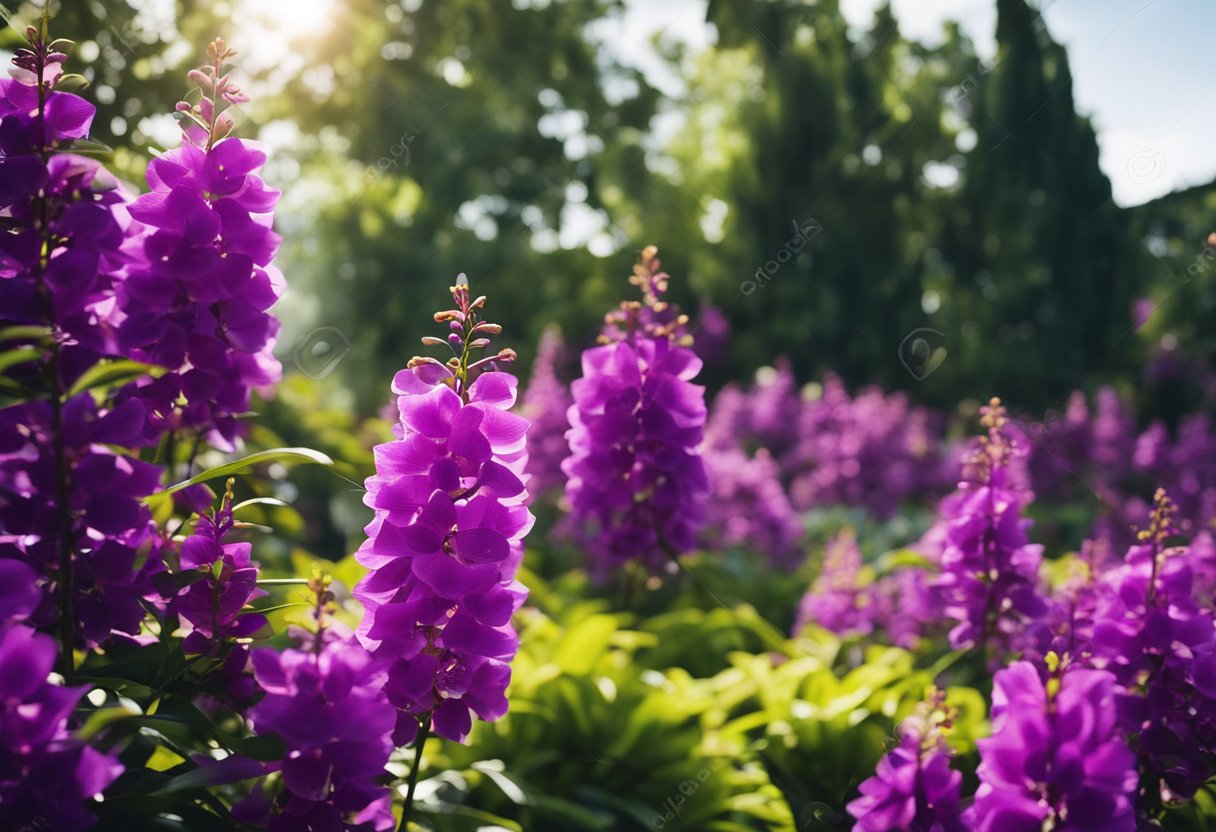
The Purple Orchid Tree, also known as Bauhinia variegata, is a small to medium-sized deciduous tree that belongs to the family Fabaceae. It is native to Southeast Asia and commonly found in India, Pakistan, and China.
Ornamental Value
The Purple Orchid Tree is highly valued for its ornamental value. It produces beautiful, fragrant, and showy flowers that range in color from light pink to purple. The flowers are large, up to 10 cm in diameter, and bloom in clusters from late winter to early spring. The tree also has an attractive foliage that is made up of two-lobed leaves that resemble butterfly wings.
Climate Adaptation
The Purple Orchid Tree is adaptable to a wide range of climates and can be grown in tropical, subtropical, and temperate regions. It prefers full sun and well-drained soil but can tolerate some shade and moist soil. It is also drought-tolerant and can withstand occasional frost. The tree is easy to grow and maintain, making it a popular choice for home gardens and landscaping.
The Purple Orchid Tree is a beautiful and versatile tree that can add color and interest to any landscape. Its ornamental value and adaptability make it a popular choice for both novice and experienced gardeners.
Saucer Magnolia
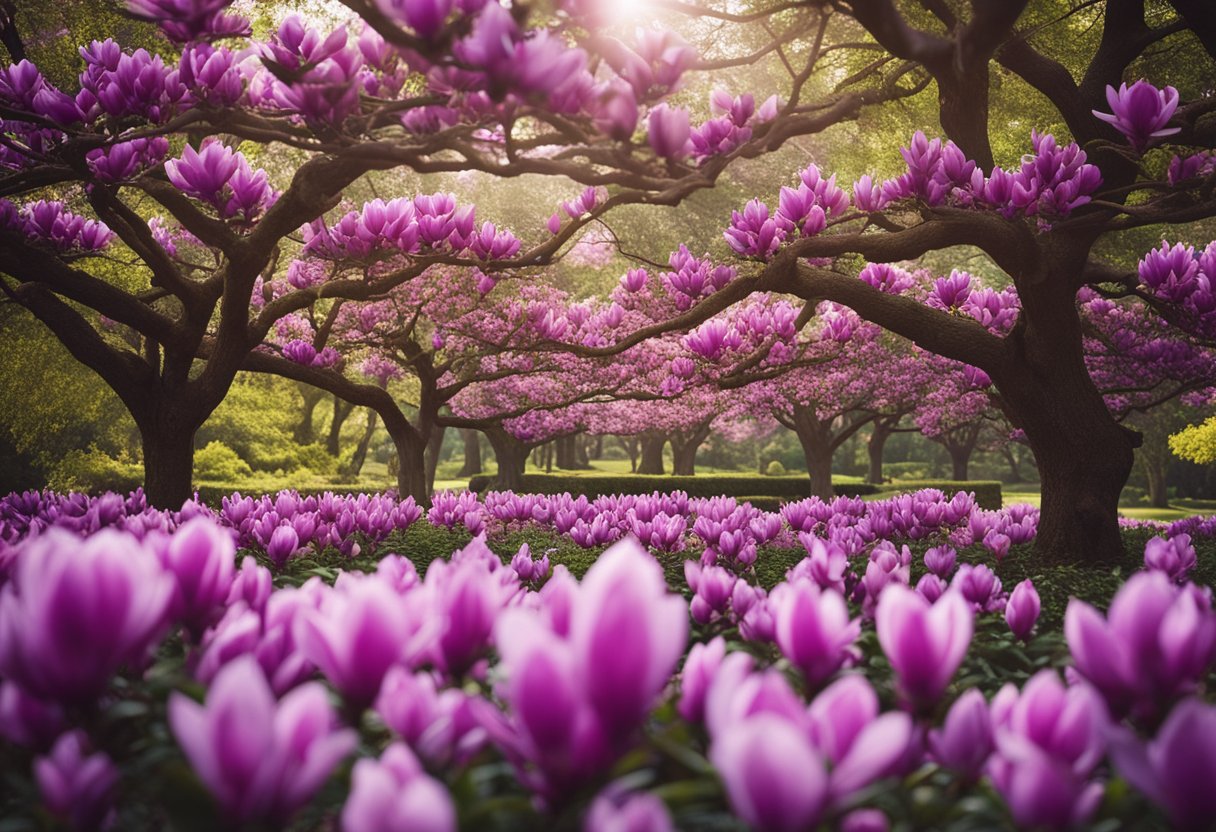
Saucer Magnolia is a deciduous tree that is native to China. It is also known as Magnolia x soulangiana. Saucer Magnolia is one of the most popular magnolia trees grown in the United States and is widely planted for its beautiful flowers.
Bloom Characteristics
Saucer Magnolia has large, showy flowers that are pink, purple, or white in color. The flowers are cup-shaped and can be up to 10 inches in diameter. They bloom in early spring, before the leaves appear on the tree.
Size and Structure
Saucer Magnolia is a small to medium-sized tree that can grow up to 30 feet tall and 20 feet wide. It has a rounded shape and a dense, spreading canopy. The leaves are dark green and oval-shaped, and can be up to 8 inches long.
Saucer Magnolia is a popular ornamental tree that is often planted in gardens and parks. It is a low-maintenance tree that requires little pruning or care. Saucer Magnolia is also tolerant of a wide range of soil types and can grow in full sun or partial shade.
Saucer Magnolia is a beautiful tree with stunning flowers that are sure to add color and interest to any landscape.
Crape Myrtle
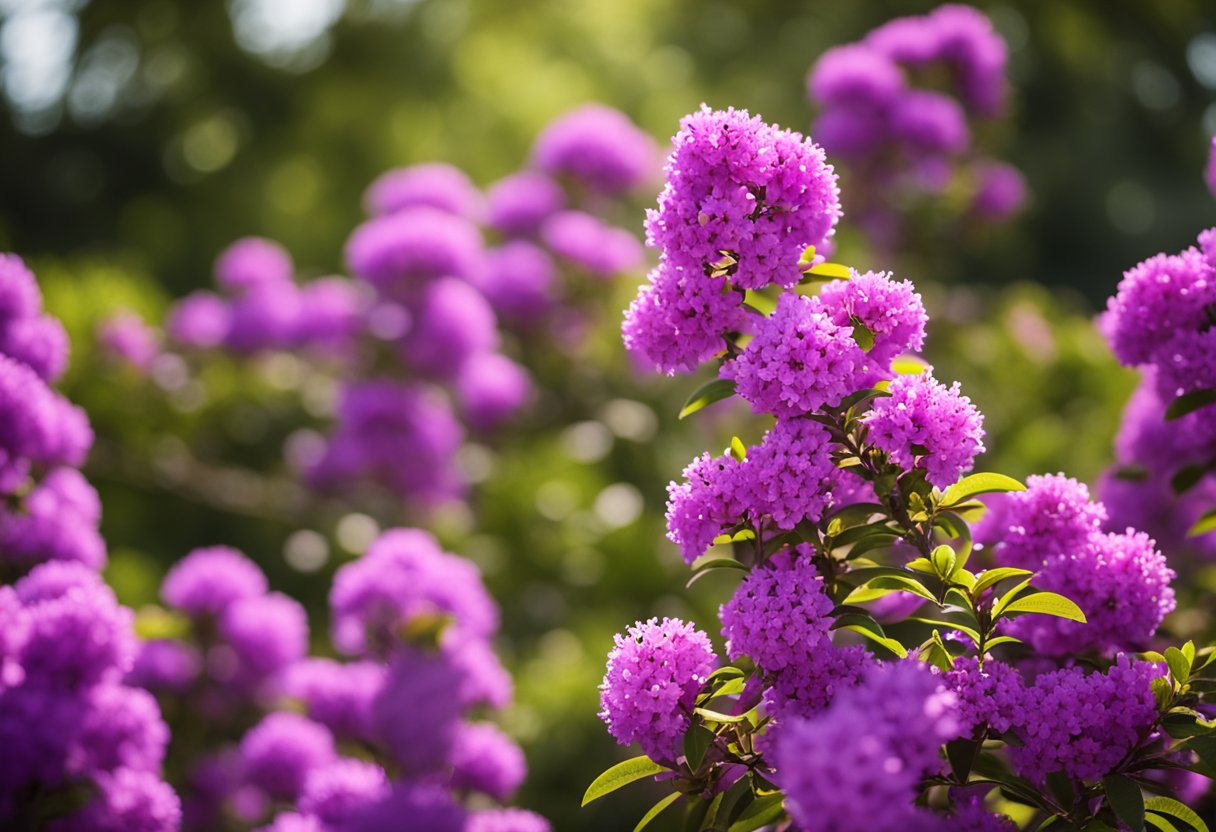
Crape Myrtle (Lagerstroemia) is a popular ornamental tree that produces beautiful purple flowers. As a landscape tree, it is highly valued for its attractive bark, summer flowers, and fall foliage. In this section, I will discuss the Varietal Diversity and Pest and Disease Resistance of Crape Myrtle.
Varietal Diversity
Crape Myrtle comes in a wide variety of colors, including purple, pink, red, and white. Some popular purple varieties include ‘Catawba,’ ‘Muskogee,’ and ‘Natchez.’ These varieties produce large clusters of flowers that can last up to 120 days. They are also highly resistant to powdery mildew and Crape Myrtle Bark Scale (CMBS), which are common problems for other varieties.
Pest and Disease Resistance
Crape Myrtle is a relatively low-maintenance tree that is resistant to many pests and diseases. However, it can be susceptible to CMBS, which is a small insect that feeds on the bark of the tree. To prevent CMBS infestations, it is important to maintain good tree health by providing regular watering, fertilization, and pruning. In addition, planting resistant varieties such as ‘Catawba’ and ‘Muskogee’ can help prevent CMBS infestations.
Crape Myrtle is an excellent choice for gardeners looking for a low-maintenance tree with beautiful purple flowers. With proper care and maintenance, it can provide years of enjoyment and beauty in the landscape.
Also Read | 10 Varieties of Yellow Perennial Flowers: A Comprehensive Guide
Conclusion

In conclusion, these 10 varieties of trees with purple flowers are a beautiful addition to any landscape. From the stunning purple blooms of the Jacaranda tree to the fragrant lavender flowers of the Lilac tree, each tree offers its unique beauty and charm.
When choosing a tree with purple flowers, it’s essential to consider factors such as size, growth rate, and climate suitability. For instance, the Crape Myrtle tree is an excellent choice for warm climates, while the Eastern Redbud tree can thrive in a wide range of climates.
Additionally, it’s worth noting that some of these trees, such as the Purple-Leaf Plum tree, can also produce edible fruit. The fruit of the Purple-Leaf Plum tree is a popular ingredient in jams and jellies due to its sweet flavor and deep purple color.
These 10 varieties of trees with purple flowers offer a range of benefits, from their aesthetic appeal to their potential for culinary use. Whether you’re looking to add color to your garden or create a focal point in your landscape, there is a tree on this list that can fit your needs.
FAQs – Varieties of Trees with Purple Flowers
What are the common names of trees that bloom with purple flowers?
There are several common names of trees that bloom with purple flowers such as Jacaranda, Royal Empress, Purple Robe Locust, Eastern Redbud, and Red Horse Chestnut. These trees are known for their showy and vibrant blooms that make them a popular choice for landscaping.
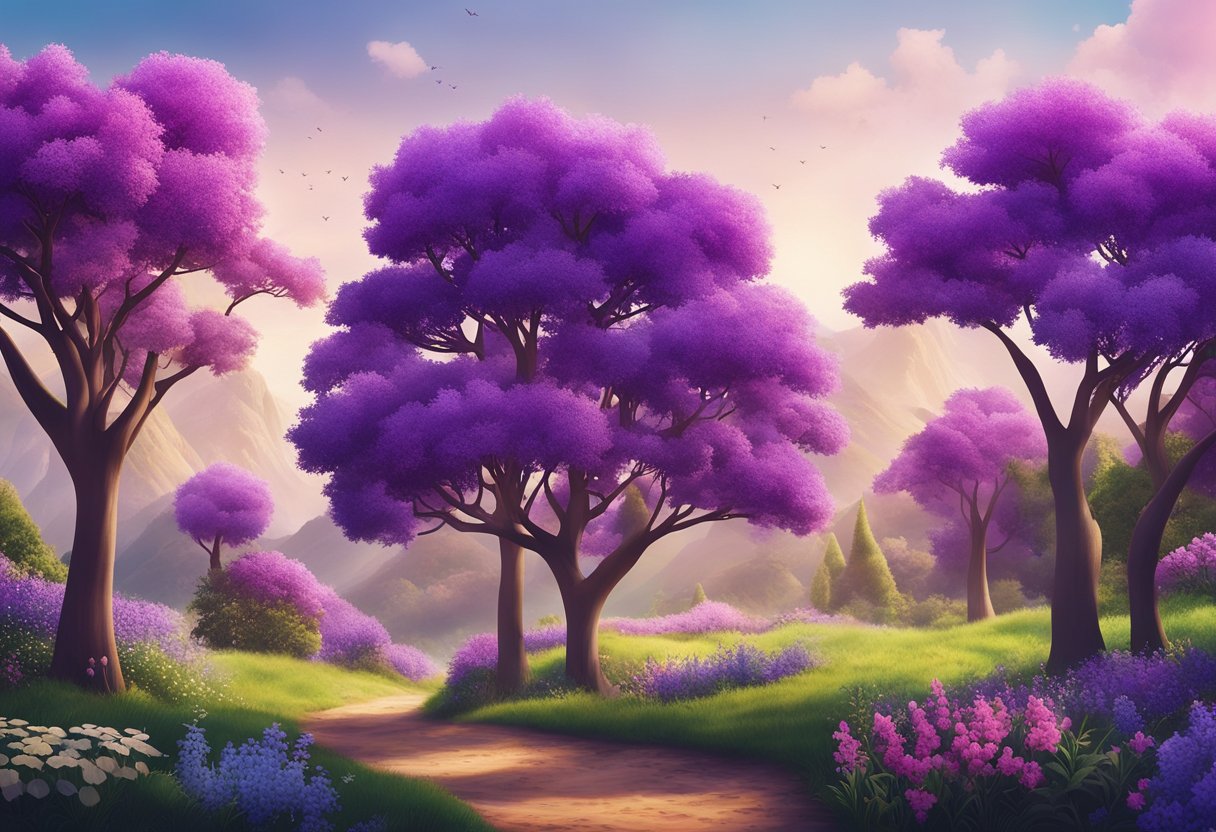
Which species of trees with purple flowers are considered invasive?
Some species of trees with purple flowers such as Princess Tree (Paulownia tomentosa) and Tree of Heaven (Ailanthus altissima) are considered invasive in certain regions. These trees have the potential to spread rapidly and outcompete native species, leading to ecological imbalances.
Can you list trees that have both purple flowers and purple leaves?
Yes, some trees have both purple flowers and purple leaves such as Purple-leaf Plum (Prunus cerasifera), Purple-leaf Sand Cherry (Prunus x cistena), and Purple-leaf Smoke Tree (Cotinus coggygria). These trees are known for their striking purple foliage and colorful blooms.
Are there any purple-flowering trees native to Texas?
Yes, there are several purple-flowering trees native to Texas such as Texas Redbud (Cercis canadensis var. texensis), Eve’s Necklace (Styphnolobium affine), and Mexican Buckeye (Ungnadia speciosa). These trees are adapted to the local climate and provide important habitat for native wildlife.
What are the options for purple-flowering trees suitable for planting in Florida?
Some options for purple-flowering trees suitable for planting in Florida include Jacaranda (Jacaranda mimosifolia), Crape Myrtle (Lagerstroemia indica), and Redbud (Cercis canadensis). These trees are known for their adaptability to the local climate and soil conditions.
What time of year do purple-flowering trees typically bloom?
The blooming time of purple-flowering trees varies depending on the species and climate. Generally, purple-flowering trees bloom in spring or early summer, but some species may bloom in fall or winter. It is best to consult with a local nursery or horticulturist for specific information on blooming times for different species.